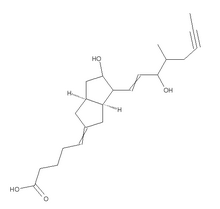PURPOSE: Inhaled iloprost, a prostacyclin analogue, is safe and effective monotherapy for PAH. Combination therapy may enhance treatment options for PAH. We assessed the safety and efficacy of adding inhaled iloprost to bosentan in PAH.
METHODS: In this prospective multicenter study, PAH patients on a stable dose of bosentan were randomized to inhaled iloprost 5 mcg or placebo 6 times daily up to 9/day for 12 weeks. Patients were evaluated for safety and the following efficacy measures: change in 6-minute walk distance (6-MWD), Borg Dyspnea Score, NYHA Class, time-to-clinical-worsening, and hemodynamics.
RESULTS: Fifteen U.S. centers enrolled 67 PAH patients (55% idiopathic PAH, 45% associated PAH). The mean age was 50 years and 79% were female. Most patients were in NYHA class III (94%) with a mean baseline 6-MWD of 338 m. Inhalation dosing compliance was 94% in both groups, with most taking 6 inhalations/day and 125 mg BID bosentan. At Week 12, patients receiving iloprost had a mean increase of 30 m in their 6-MWD compared to baseline (p = 0.0013), while those on placebo had a mean increase of 4 m (p = 0.69), with a placebo-adjusted difference of +26 m (p = 0.0513). This was accompanied by a reduction in Borg Dyspnea Score in the iloprost group (P=0.03 vs baseline). NYHA class improved by one Class in 34% iloprost patients compared with 6% placebo (p = 0.0023). Iloprost delayedtime-to-clinical-worsening (p = 0.0219) with 0/32 iloprost patients and 5/33 (15%) placebo patients experiencing clinical deterioration. Improvements were noted in placebo adjusted change in mPAP, 8 mmHg (p <0.0001), and PVR, 244 dynesxsecxcm-5 (p = 0.0007). Adverse events with combination therapy were consistent with the known safety profile of inhaled iloprost and included cough, headache, jaw pain and flushing. Syncope was infrequent overall (1 iloprost, 2 placebo).
CONCLUSION: Combination therapy with inhaled iloprost and bosentan was safe and provided additional efficacy compared with bosentan alone.
CLINICAL IMPLICATIONS: Inhaled iloprost may be a useful adjunct therapy to bosentan in PAH patients.
DISCLOSURE: Vallerie McLaughlin, Grant monies (from industry related sources); Consultant fee, speaker bureau, advisory committee, etc.
Vallerie V. McLaughlin MD * Ronald Oudiz MD Adaani Frost MD Victor Tapson MD Srinivas Murali MD Richard Channick MD David Badesch MD Robyn Barst MD Henry Hsu MD Lewis Rubin MD University of Michigan, Ann Arbor, MI
COPYRIGHT 2005 American College of Chest Physicians
COPYRIGHT 2005 Gale Group



